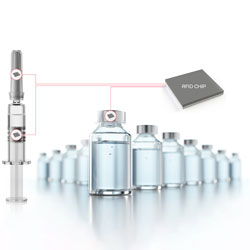
Murata introduced the small RAIN RFID tag at Pharmapack in Europe. Tags are created to provide unique identifiers that allow RFID readers to determine the identity and authenticity of items in healthcare applications. This small and rugged RFID tag can be mounted on both metal and non-metal surfaces, making it ideal for small items. To avoid any risk of contamination through drug filling operations, they can also be embedded in products, including pre-filled syringes, vials and barrels.
The company has integrated the antenna into a multi-layer ceramic substrate to produce a small but robust RFID tag capable of automatic identification and batch reading at speeds in excess of 400 units/min for high throughput efficiency. This capability enables real-time identification at full production, preventing any confusion during drug filling operations. RFID tags also provide single-grade serialization, limiting batch isolation if defects are found in the aftermarket.
Teppei Miura, General Manager of Murata ID Solutions, said, "New regulations for product traceability and quality control on production lines by health authorities such as the FDA(Food and Drug Administration) and USP(United States Pharmacopoeia) are driving the healthcare industry to identify and authenticate individual products from cradle to grave." "The small RAIN RFID tag is ideal for identifying products such as pre-filled bottles, syringes and single-use syringes during high-speed manufacturing processes and providing certified traceability in the aftermarket."
Routine tracking of preloaded vials and syringes requires qr codes as application labels or printed directly on the product surface. Unlike RFID tags, which can be read in batches, QR codes are read separately, slowing production. Since these biochemical products require strict temperature control, condensation can also make qr codes difficult to scan. Refurbished labels may also pose a risk of contamination during filling.
These challenges are overcome by embedding labels directly into the components of vials and syringes without the risk of contamination or compromising visual inspection; It also removes the process step of applying the QR code. Moreover, since all relevant information is retained in the entry, manual typing errors are eliminated.
In the aftermarket, the benefits of using labels include user navigation, including instructions for use, and third-party drug and counterfeit drug prevention. RFID tags can also be used as part of a connected ecosystem, sending usage data to the cloud for patient monitoring of rechargeable insulin syringes.